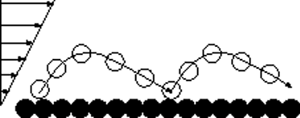Article contents
Collisionless kinetic theory for saltation over a rigid, bumpy bed
Published online by Cambridge University Press: 22 August 2024
Abstract

We employ the methods of statistical mechanics to obtain closures for the balance equations of momentum and fluctuation kinetic energy that govern the ballistic motion of grains rebounding at a rigid, bumpy bed that are driven by turbulent or non-turbulent shearing fluids, in the absence of mid-trajectory collisions and fluid velocity fluctuations. We obtain semi-analytical solutions for steady and fully developed saltation over horizontal beds for the vertical profiles of particle concentration and stresses and fluid and particle velocities. These compare favourably with measurements in discrete-element numerical simulations in the wide range of conditions of Earth and other planetary environments. The predictions of the particle horizontal mass flux and its scaling with the amount of particles in the system, the properties of the carrier fluid and the intensity of the shearing also agree with numerical simulations and wind-tunnel experiments.
Information
- Type
- JFM Papers
- Information
- Copyright
- © The Author(s), 2024. Published by Cambridge University Press
References
- 1
- Cited by


